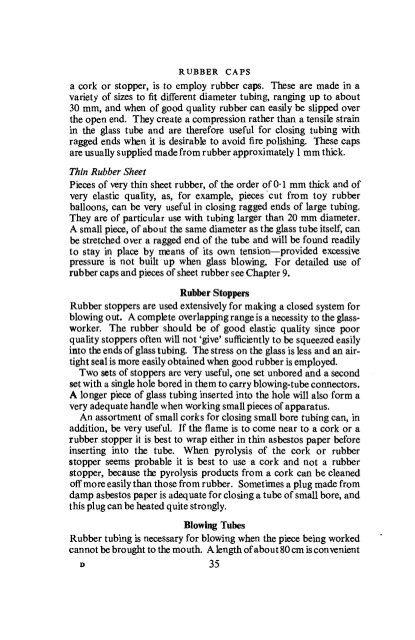Laboratory Glass-Working for Scientists - Sciencemadness Dot Org
Laboratory Glass-Working for Scientists - Sciencemadness Dot Org
Laboratory Glass-Working for Scientists - Sciencemadness Dot Org
Create successful ePaper yourself
Turn your PDF publications into a flip-book with our unique Google optimized e-Paper software.
RUBBER CAPS<br />
a cork or stopper, is to employ rubber caps. These are made in a<br />
variety of sizes to fit different diameter tubing, ranging up to about<br />
30 mm, and when of good quality rubber can easily be slipped over<br />
the open end. They create a compression rather than a tensile strain<br />
in the glass tube and are there<strong>for</strong>e useful <strong>for</strong> closing tubing with<br />
ragged ends when it is desirable to avoid fire polishing. These caps<br />
are usually supplied made from rubber approximately 1 mm thick.<br />
Thin Rubber Sheet<br />
Pieces of wry thin sheet rubber, of the order of 0-1 mm thick and of<br />
very elastic quality, as, <strong>for</strong> example, pieces cut from toy rubber<br />
balloons, can be very useful in closing ragged ends of large tubing.<br />
They are of particular use with tubing larger than 20 mm diameter.<br />
A small piece, of about the same diameter as the glass tube itself, can<br />
be stretched over a ragged end of the tube and will be found readily<br />
to stay in place by means of its own tension—provided excessive<br />
pressure is not built up when glass blowing. For detailed use of<br />
rubber caps and pieces of sheet rubber see Chapter 9.<br />
Rubber Stoppers<br />
Rubber stoppers are used extensively <strong>for</strong> making a closed system <strong>for</strong><br />
blowing out. A complete overlapping range is a necessity to the glassworker.<br />
The rubber should be of good elastic quality since poor<br />
quality stoppers often will not *give' sufficiently to be squeezed easily<br />
into the ends of glass tubing. The stress on the glass is less and an airtight<br />
seal is more easily obtained when good rubber is employed.<br />
Two sets of stoppers are very useful, one set unbored and a second<br />
set with a single hole bored in them to carry blowing-tube connectors.<br />
A longer piece of glass tubing inserted into the hole will also <strong>for</strong>m a<br />
very adequate handle when working small pieces of apparatus.<br />
An assortment of small corks <strong>for</strong> closing small bore tubing can, in<br />
addition, be very useful. If the flame is to come near to a cork or a<br />
rubber stopper it is best to wrap either in thin asbestos paper be<strong>for</strong>e<br />
inserting into the tube. When pyrolysis of the cork or rubber<br />
stopper seems probable it is best to use a cork and not a rubber<br />
stopper, because the pyrolysis products from a cork can be cleaned<br />
off more easily than those from rubber. Sometimes a plug made from<br />
damp asbestos paper is adequate <strong>for</strong> closing a tube of small bore, and<br />
this plug can be heated quite strongly.<br />
Blowing Tubes<br />
Rubber tubing is necessary <strong>for</strong> blowing when the piece being worked<br />
cannot be brought to the mouth. A length of about 80 cm is convenient<br />
n 35
















